|
A History of Pre-War Automotive
Tootsietoys
by Clint Seeley edited by Robert Newson Part 3 - Late 1920s issues, including the General Motors series and Model A Fords Clint Seeley's original text is in green, and my editorial additions are in blue. Put your mouse over the thumbnail images to see the picture caption, and click on the thumbnail to enlarge. Last month we wrapped up the "early" Mack series, which lasted in some form until the Second World War curtailed production of metal toys. This month we'll go back to the next introductions after the first Macks. I have not seen catalogues for 1926, 1927, or 1928, though there is a 1928 ad from an N.Shure catalogue which has already been widely circulated amongst the collecting fraternity. So I'm not dead sure of which years saw just what during this interval, and may be off by a year. There is a 1926 catalogue supplement known to exist, suggesting that Tootsietoy continued to use the 1925 catalogue with the supplement showing new issues (page 283 in ref.5). Tootsietoys were also included in the wholesale catalogues of Butler Brothers from 1927 to 1930 and these are reproduced on this page and the next. Below left are pages from the 1926 supplement, and right a two-page colour Tootsietoy advertisement in the January 1927 issue of the trade magazine Playthings:
 This "Partitoys" gift set looks like
it is from this period. This "Partitoys" gift set looks like
it is from this period. 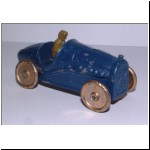 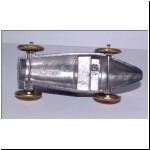 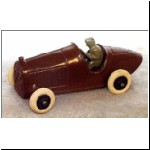 One of the few cars to have wheels other than the standard discs was a small racer (no.23) with that number cast on its radiator. It was originally issued (in 1926) with a removable driver. In keeping with the risks of his profession, he was usually promptly lost, and most of these racers extant today have a small vacant square hole in the seat in his memory. Later versions had the peg in the driver's seat peened over, and a few with this permanent driver have survived. 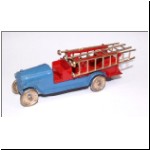  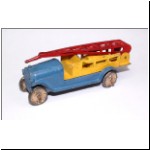 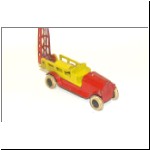   A
popular pair of
releases were two fire engines, no.4652 hook and
ladder and no.4653 water tower, issued
in 1927 (ref.1).
These had the same chassis
casting with different bodies. They were also sold in a boxed set
with one chassis and the two interchangeable bodies. The red (or blue) and
yellow water tower had the boom hinged at the rear to allow it to swing
erect. The red and blue hook and ladder was fitted with three
gilt ladders, and rings at the bottom of the ladders
allowed them to be interlocked and erected on small lugs on the rear
platform. A
popular pair of
releases were two fire engines, no.4652 hook and
ladder and no.4653 water tower, issued
in 1927 (ref.1).
These had the same chassis
casting with different bodies. They were also sold in a boxed set
with one chassis and the two interchangeable bodies. The red (or blue) and
yellow water tower had the boom hinged at the rear to allow it to swing
erect. The red and blue hook and ladder was fitted with three
gilt ladders, and rings at the bottom of the ladders
allowed them to be interlocked and erected on small lugs on the rear
platform.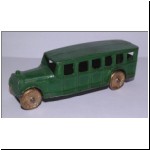 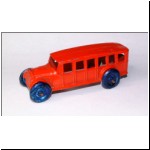 A typical bus of the
day, no.4651, similar to those on the road made by
Fageol and Yellow Coach, represented a small vehicle by today's
standards, being much like the elongated airport limousines with doors
on each side for each rank of seats (introduced 1926). The
catalogue merely
described it as a "perfect reproduction of a well-known make of Safety
Coach". It must have been a popular toy, as, along with the fire
engines, it is among the less rare from the period in collections
today, despite being joined
in 1929 by the harder to find "Overland
Bus Llnes" model. The
model in the second picture is a copy of the Tootsietoy made in England
by Johillco and introduced around 1932. A typical bus of the
day, no.4651, similar to those on the road made by
Fageol and Yellow Coach, represented a small vehicle by today's
standards, being much like the elongated airport limousines with doors
on each side for each rank of seats (introduced 1926). The
catalogue merely
described it as a "perfect reproduction of a well-known make of Safety
Coach". It must have been a popular toy, as, along with the fire
engines, it is among the less rare from the period in collections
today, despite being joined
in 1929 by the harder to find "Overland
Bus Llnes" model. The
model in the second picture is a copy of the Tootsietoy made in England
by Johillco and introduced around 1932.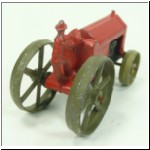  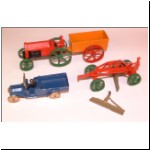  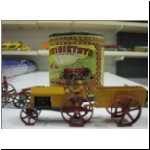  A beautifully
detailed farm tractor, no.4654, was a two-piece casting,
with the engine showing through the open sides of the hood and an
integrally cast driver on the saddle. It was issued in 1927 (ref.1), and from 1928, it was
fitted with
a tow-rlng and sold in various sets. The "Farm Tractor Outfit" pictured
included a box trailer
and a road scraper which had interchangeable blade and rake
pieces, as
well as the Model T Ford truck. This was one of several sets in
"Akana" packaging - literally a can-shaped mailing carton - which were
produced from 1928 to 1930, after which the tractor set was packed in a
normal display box (no.7003). A later set had the tractor
towing a cannon (there were howitzer and
mortar versions), and the tractor was modified for these military
sets by shortening the hood and adding a large ammo box, with
lettering "U.S.A. W-1881" cast, at the rear.
The army version is quite a bit scarcer than its bucolic brother (see photo in part 4). A beautifully
detailed farm tractor, no.4654, was a two-piece casting,
with the engine showing through the open sides of the hood and an
integrally cast driver on the saddle. It was issued in 1927 (ref.1), and from 1928, it was
fitted with
a tow-rlng and sold in various sets. The "Farm Tractor Outfit" pictured
included a box trailer
and a road scraper which had interchangeable blade and rake
pieces, as
well as the Model T Ford truck. This was one of several sets in
"Akana" packaging - literally a can-shaped mailing carton - which were
produced from 1928 to 1930, after which the tractor set was packed in a
normal display box (no.7003). A later set had the tractor
towing a cannon (there were howitzer and
mortar versions), and the tractor was modified for these military
sets by shortening the hood and adding a large ammo box, with
lettering "U.S.A. W-1881" cast, at the rear.
The army version is quite a bit scarcer than its bucolic brother (see photo in part 4).General Motors Series 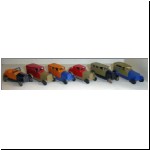 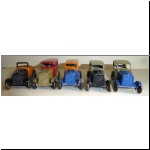 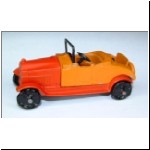 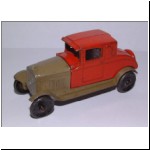 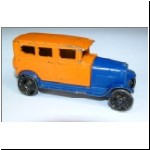     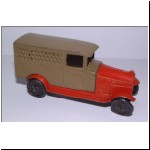 Thls group of cars, introduced in 1927 (ref.1), consisted of six different bodies which were interchangeable on four different chassis, and thus allowed for 24 different versions, each with its own catalogue number. The numbering was systematlc, but too complicated to go into here. I'll leave it to you to figure it out on the master list, to be published at the conclusion of this series (parts 8 & 9). Suffice it here to say that they span numbers between 6001 and 6306. The six bodies were: roadster, coupe, sedan, brougham, touring car with the top up and a screenslde panel delivery van. The four GM chassis were Chevrolet, Buick, Oldsmobile and Cadillac. These were dimensionally identical from the cowl to the rear, where the body pieces fitted, but differed in the size and length of the hood (bonnet) and radiator, as well as in the grille pattern and the embossed name across it. The body and chassis pieces were always in contrasting colours, the chassis in medium blue, black, red, yellow-orange and tan-ish olive, and the bodies in red, yellow-orange, green, dark blue and the tan-ish olive. Late in the series, a nameless version was introduced with a grille only slightly different from the Chevrolet and a slightly larger oval emblem at the top. Some collectors are sure that this is the Chevrolet trade-mark, but all of mine, some in mint shape and very clean castings, cannot be credited with more than being a smooth, oval blob.  A word should be
injected here to state with almost absolute assurance
that there never was a member of the series marked "Oakland". The
1928 N.Shure ad (pictured here)
notes an Oakland delivery van, but this is certainly a
misprint, and should have been "Oldsmobile". There are many
compelling reasons for arguing that an Oakland was never made, amongst
which are the phasing out of this marque in favour of the Pontiac at
the time the models were made, the simplicity of packaging of a line of
an even two dozen different types, the absence of any mention of an
Oakland in available catalogues and the inability of any of the people
employed at the plant at that time to recall an Oakland today. Probably
the most compelling reason to exclude it is simply that I know of none
in anyone's collection, whilst a few hundred other GM models have
passed beneath my admiring gaze. l'd be delighted if any reader
could prove me wrong (I said prove,
and you can do so simply by mailing the Oakland to Andover for
authentication, if not permanent display in the museum). A word should be
injected here to state with almost absolute assurance
that there never was a member of the series marked "Oakland". The
1928 N.Shure ad (pictured here)
notes an Oakland delivery van, but this is certainly a
misprint, and should have been "Oldsmobile". There are many
compelling reasons for arguing that an Oakland was never made, amongst
which are the phasing out of this marque in favour of the Pontiac at
the time the models were made, the simplicity of packaging of a line of
an even two dozen different types, the absence of any mention of an
Oakland in available catalogues and the inability of any of the people
employed at the plant at that time to recall an Oakland today. Probably
the most compelling reason to exclude it is simply that I know of none
in anyone's collection, whilst a few hundred other GM models have
passed beneath my admiring gaze. l'd be delighted if any reader
could prove me wrong (I said prove,
and you can do so simply by mailing the Oakland to Andover for
authentication, if not permanent display in the museum).Model A Fords   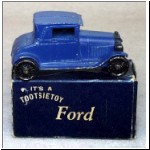 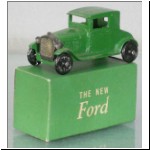 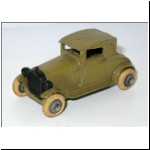 In the autumn of 1927, Henry Ford introduced the new Model A Ford, which was developed under the tightest wraps of secrecy. A few months later, Dowst introduced the coupe (no.4655) under the banner "The big secret of 1927 exposed!" lt was likely the toy scoop of the year. It was the first Tootsietoy to be sold individually boxed, a practice later made standard by Dlnky and most other major manufacturers after World War II. The boxes were in four different colours, coinciding with the paint on the models enclosed: red, blue, green and khaki. (Clint mentioned a yellow version, but that seems to apply only to the sedan. The red, blue, green and brown colours of the coupe are mentioned in the 1929 leaflet pictured in part 4). The khaki coupe was also sold in military sets a few years later. The coupe was intended to represent the convertible roadster with top up, and had landau "S" irons on the rear quarters.   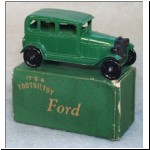 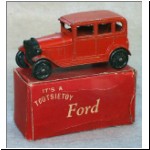 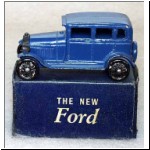 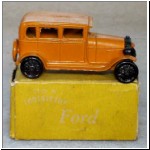 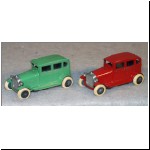 In 1929, the sedan
was added to the Model A line, and had somewhat more
rounded lines, and a nice cast-on rear spare tyre with "Ford" in script
across the wheel cover. It also showed the gas tank cap in the
centre of the cowl, just in front of the windshield. Clint listed the sedan as no.6665,
but this was an error for 4665. The error was perpetuated in the
Wieland & Force book (ref.10).
I am not sure how the error occurred, because the correct number is
more logical, and was shown in the 1931 leaflet and in catalogues for
1932 and 1933. Perhaps 6665 is a misprint in a catalogue that I
have not seen. In 1929, the sedan
was added to the Model A line, and had somewhat more
rounded lines, and a nice cast-on rear spare tyre with "Ford" in script
across the wheel cover. It also showed the gas tank cap in the
centre of the cowl, just in front of the windshield. Clint listed the sedan as no.6665,
but this was an error for 4665. The error was perpetuated in the
Wieland & Force book (ref.10).
I am not sure how the error occurred, because the correct number is
more logical, and was shown in the 1931 leaflet and in catalogues for
1932 and 1933. Perhaps 6665 is a misprint in a catalogue that I
have not seen. 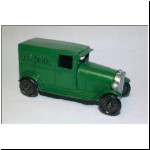   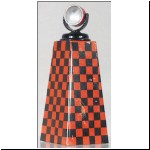 The Mail van did not appear until the 1931 catalogue, and was never listed separately with its own number. It was invariably shown in the boxed "Air Mail" set no.5041, also including the Mack airmail truck, aeroplanes, six figures and a pylon with searchlight on top. The pylon was tinplate, with the searchlight as used on the Mack truck. The Model A Mail Van was either light or dark green. The Model A Fords were fitted with new wheels, representing wire spokes, and were the first deviation from the disc wheels used on other vehicles. The Tootsietoy page from the 1928 Butler Bros. catalogue:  This and the N.Shure catalogue (above) were the first to include the GM series and the "new Ford".  The retailer's
counter-top display stand pictured here probably dates from this era. The retailer's
counter-top display stand pictured here probably dates from this era.Next month we'll have a look at some of the early patents, and then march on into the early 1930s. References (1) "From Line-O-Type to the Funnies - The Birth of Tootsietoys" in Automobile Year Book of Models no.3, 1984, Editions 24 Heures, Lausanne. (5) The Complete Book of Building and Collecting Model Automobiles by Louis H.Hertz, Crown Publishers Inc., New York, 1970. (10) Tootsietoys - World's First Diecast Models by James Wieland & Edward Force, Motorbooks International Publishers & Wholesalers Inc., Osceola, Wisconsin, 1980. |
||||||
© Robert Newson





